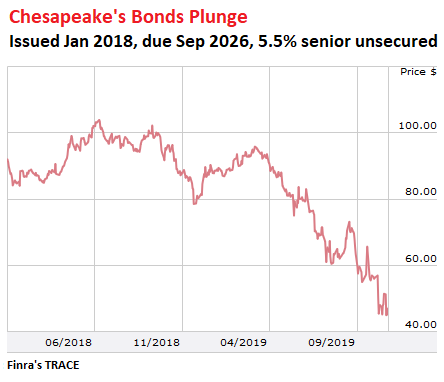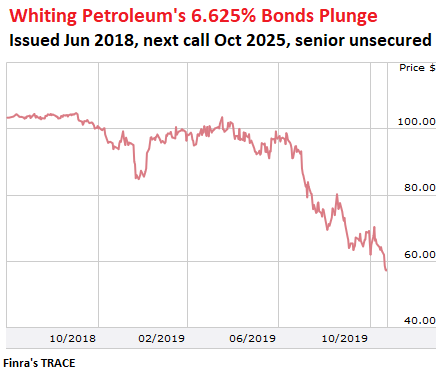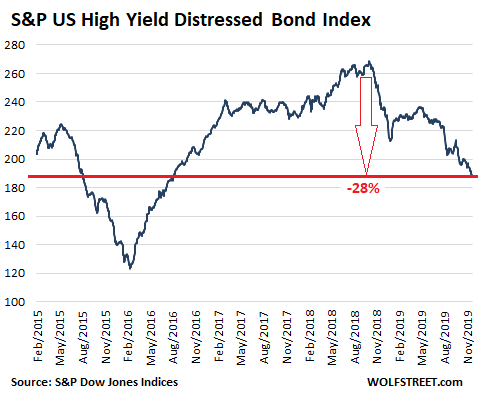Fracking Blows Up Investors Again: Phase 2 of the Great American Shale Oil & Gas Bust
by Wolf Richter, Wolf Street:
 Including billionaires who thought they’d picked the bottom in 2016.
Including billionaires who thought they’d picked the bottom in 2016.
In 2019 through third quarter, 32 oil and gas drillers have filed for bankruptcy, according to Haynes and Boone. Since the end of September, a gaggle of other oil and gas drillers have filed for bankruptcy, including last Monday, natural gas producer Approach Resources. This pushed the total number of bankruptcy filings of oil and gas drillers since the beginning of 2015 to over 200. Other drillers, such as Chesapeake Energy, are jostling for position at the filing counter.
Chesapeake has been burning cash ever since it started fracking. To feed its cash-burn machine, it has borrowed large amounts and has been buckling under its debt for years, selling assets to raise cash and keep drilling for another day. But its debt is still nearly $10 billion. Its shares [CHK] closed on Friday at 59 cents.
On November 5, in an SEC filing, it warned of its own demise unless oil and gas prices surge into the sky asap: “If continued depressed prices persist, combined with the scheduled reductions in the leverage ratio covenant, our ability to comply with the leverage ratio covenant during the next 12 months will be adversely affected which raises substantial doubt about our ability to continue as a going concern.”
In early 2016, during Phase 1 of the oil bust — which had started in mid-2014 — Chesapeake had already used the threat of bankruptcy to push its creditors into accepting a debt restructuring. At the time, it was the second largest natural gas producer in the US.
The debt restructuring reduced its debt burden somewhat and pushed maturities out, which then allowed it to borrow new money from new investors with a series of bond sales. This coincided with the Wall Street floodgates reopening to the oil and gas sector, when PE firms, hedge funds, and distressed-debt funds piled billions of dollars into the sector, and many of the oil and gas drillers were able to raise more cash to burn.
Chesapeake’s series of bond sales that it then undertook included, in January 2018, $1.25 billion of senior unsecured convertible notes with a coupon of 5.5%, due in September 2026. It issued those bonds at a discount, but by July 2018, a few months before Phase 2 of the oil bust set in, the bonds were trading at 103 cents on the dollar. On Friday, the last trade was at 45 cents on the dollar, giving these bonds a yield of over 21% (via TRACE, FINRA’s Trade Reporting and Compliance Engine):

Other exploration and production (E&P) companies have seen their shares get crushed as reality began to re-set in.
Whiting Petroleum shares [WLL] had spiked to $370 in August 2014, when the oil bust was setting in. By the trough of Phase 1 of the oil bust, in February 2016, its shares had plunged to $14. Then new money started flowing into the sector, and its shares rallied to $55 by August last year. Then Phase 2 of the oil bust set in, and after some disastrous earnings reports, its shares closed on Friday at $5.34.
In June 2018, Whiting sold $1 billion of callable senior unsecured bonds, with a coupon of 6.625%. The next call date is in October 2025. Through September 2018, the notes were trading at 103-104 cents on the dollar. Then Phase 2 of the oil bust took its toll. On Friday, the bonds closed at 57.8 cents on the dollar, at a yield of 18.375% (via FINRA’s TRACE):

The S&P U.S. High Yield Corporate Distressed Bond Index tracks bonds that trade at a yield that is at least 10 percentage points higher than the equivalent Treasury yield (“Option Adjusted Spread” of 1,000 basis points). Chesapeake’s bond illustrated above, trading at 21%, and Whiting’s bond trading at 18.375% qualify for this index with flying colors. Of the 182 constituents in the index, many are energy bonds. Since November 2018, the index has plunged by 28%:

Now there are stories circulating of how billionaires, who in 2016 believed the hype that the fracking bust was over, have gotten tangled up and lost tons of money on their bets. Bloomberg recounts one such story, of the brothers Farris and Dan Wilks in Texas.
In 2002, they’d turned their stone-mason expertise into Frac Tech Holdings. Chesapeake, the fracking pioneer with the collapsed shares and bonds above, acquired a 25.8% state in 2006. They became billionaires in 2011 when they sold the remainder of the company to an investor group led by Temasek Holdings, which is owned by the Government of Singapore, for $3.5 billion. They then bought large swaths of land in five states, becoming the top property owners in Montana and Idaho.
However, not all of their wealth went into real estate. In 2016, the brothers started investing heavily in the fracking industry through their investment company, Wilks Brothers LLC, including oil and gas drillers in the Permian Basin and suppliers, such as frac sand supplier Carbo Ceramics, of which the brothers are the second largest investors.
Back in 2015, Carob Ceramics [CRR] still traded at over $40 a share. By October 2016, shares had dropped into the $6-range. Then the Permian boom started, and in early 2018, shares were trading at $12. But then the long hard decline continued, as demand for frac sand vanished as drillers were running out of cash and cut back on their drilling activity, and on Friday, shares closed at 41 cents.
Loading...

